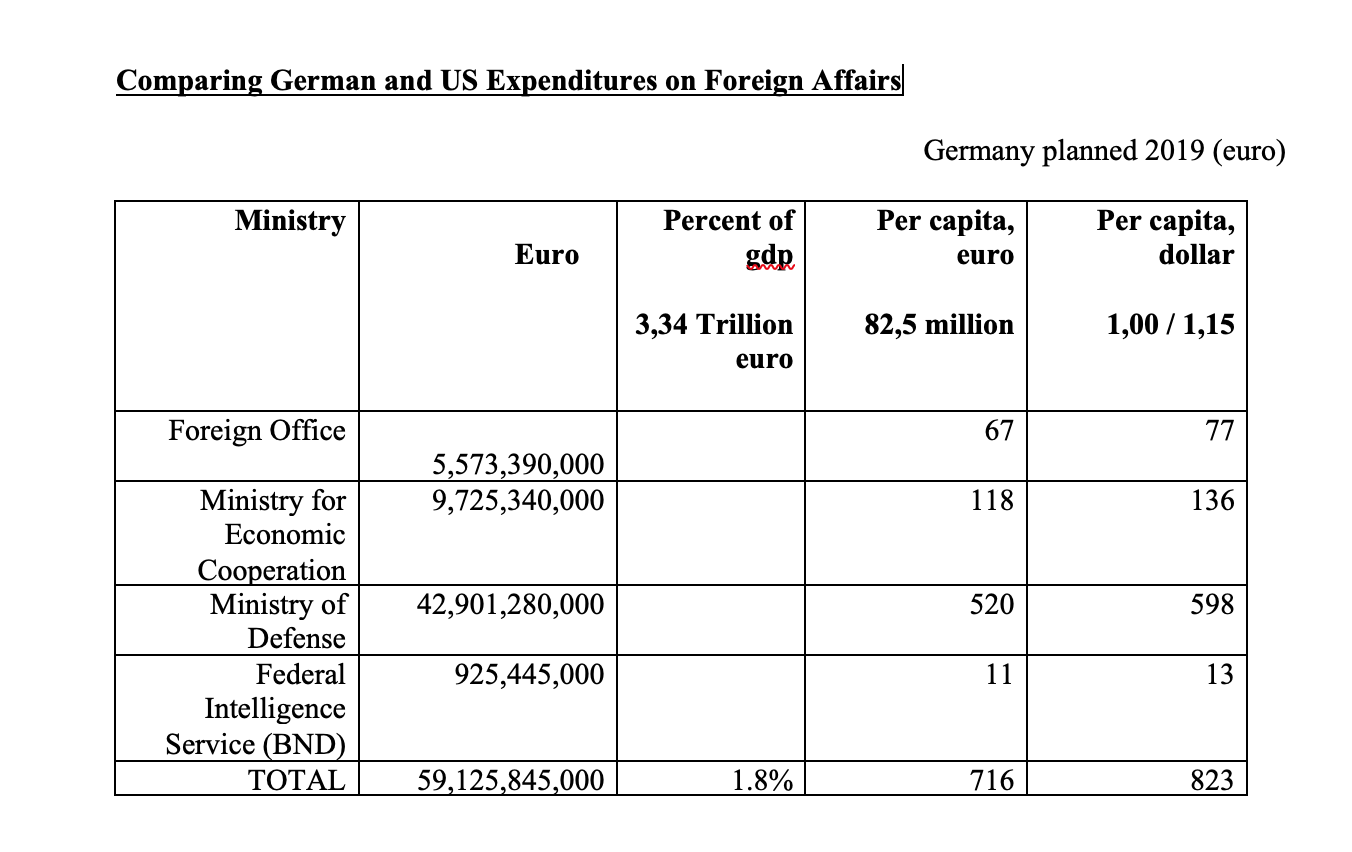The Return of Direct European Defense: The German Challenge
For the last three years, I have travelled extensively in Northern Europe to discuss the Russian challenge and the return of direct defense.
During a visit to Germany in February 2019, I am visiting Germany to discuss with German experts and retired senior German military, their assessments of the challenge to Germany and the way ahead to deal with direct defense of Germany and its contribution to deterrence.
My visit started with a discussion with Dr. Andrew Dennison, the Director of Transatlantic Network, which is a think tank with focus on political education and consultancy.

Dr. Dennison attended Johns Hopkins’s School of Advanced International Studies when I taught there and it was great to bridge from the past when West Germany had a solid military capability to defend itself and support its allies to the current period where the hollowing out of German defense is becoming reversed.
According to Dennison: “Germany is a very rich country that benefits from the peace and prosperity in Europe more than any other country, and it needs to spend about twice as much as it does on the three D’s : Defense development, and diplomacy.
“Many people discuss the 2% goal for defense as a percentage of GDP is discussed. Wolfgang Ischinger, head of the Munich Security Conference suggests spending 3 % of GDP on defense, diplomacy and development—so as to not appear overly militaristic.
“Unfortunately, Germany is still under 2 % on this broader index of international engagement.”
“The Germans spend 600 dollars per capita on defense and the Americans spend about $2700 per capita.
“The Germans spend 13 dollars per capita on intelligence (BND), the Americans spend about a 180 per capita on the intelligence community (DNI).
“In the information age it would say that’s a crazy under investment.
“Only on diplomacy and development do the Germans outspend the Americans, with the Germans at about $213 per capita, and the Americans at $186”
“And it is not just about defense, it is about the 3Ds.
“For example, Germany should spend twice as much on its foreign ministry to focus on tasks like helping Ukraine fight corruption, to deal with the Balkans and to deal with Syria and the refugees.
“There needs to be a comprehensive and strategic effort by the Germans to deal with the new threats.”
“Germany’s challenge is to recognize that history and geography have not disappeared as key factors shaping Germany’s prosperity and security; and that Germany needs to focus upon re-energizing the European project.
“If Germany became a nation isolated in a disaggregating Europe, Germany itself might disintegrate as a political force.”
He underscored that resetting the German effort was a strategic challenge which required culture change.
It was about getting real about the evolving situation and that the more comfortable world of the 1990s is gone.
“The hardest thing is how to create a willingness among Germans to sacrifice for the broader German or European good. Germany needs to create a strategic culture that sees the world as what it is rather than as it was or what we (I am almost German) think it was.”
We discussed what technologies and forces Germany needed to invest in to provide for the common defense.
He argued that NATO had done a good job working through the coalition needs and requirements to think through how to deal with the direct defense challenge.
But it remained for Germany to invest in those forces.
“We agree on what’s necessary.
“What we don’t agree on is how much is necessary to spend to get those things.
“That’s really where I see the problem.”

 Excerpt from Konzeption der Bundeswehron country and alliance defense.
Excerpt from Konzeption der Bundeswehron country and alliance defense.
Landes- und Bündnisverteidigung
Der Charakter der Landes und Bündnisverteidigung hat sich für Deutschland im Gegensatz zu An nahmen, die in Zeiten des Kalten Krieges gültig waren, signifikant gewandelt. Die Bedrohungslage hat sich verändert. Eine zeitgleiche symmetrische Bedrohung entlang der gesamten Grenze des NATOVertragsgebiets ist nicht zu erwarten. Vielmehr sind militärische Aktionen mit räumlich schnell wechselnden Schwerpunkten denkbar. Selbst konventionelle Streitkräfte dürften eingebettet in eine hochagile hybride Gesamtstrategie vorgehen, die auch heutige, spitzentechnologische Möglich keiten nutzt. Staatliches und gesellschaftliches Handeln kann im Bündnis in schneller Folge Ziel gegnerischer Aktionen werden.
Die Grenzen zwischen Landesverteidigung, (kollek tiver) Bündnisverteidigung und weiteren bündnis solidarischen Maßnahmen können dabei fließend sein.
Landesverteidigung dient dazu, Angriffe auf Staat und Gesellschaft abzuschrecken und Deutschland und seine Bürgerinnen und Bürger militärisch zu verteidigen. Konventionelle, symmetrische An griffe im bzw. unmittelbar am deutschen Hoheits gebiet sind NATOBündnisfall und Beistandsfall für die EU. Alle Kräfte, Mittel und Reserven werden unter Rückgriff auf die in diesem Falle geltenden gesetzlichen Grundlagen zur Verteidi gung mobilisiert.
Aber auch ohne konventionellen Angriff von außen kann hybrides gegnerisches Vorgehen, z. B. unter Nutzen des Cyber und Informationsraums oder des Weltraums, schnell Landesverteidigung er fordern. Großangelegte asymmetrische Angriffe oder massive Cyberattacken können zu einer Feststellung des Spannungs oder Verteidigungs falls führen. Hierfür stellt die Bundeswehr in res sortgemeinsamer Abstimmung einen militärischen Beitrag im Rahmen einer Strategie zur Gesamt verteidigung bereit, u. a. sofort reaktionsfähige Kräfte zur Cyber/ITLageführung und Krisen bewältigung bei Angriffen aus dem Cyberraum.
(Kollektive) Bündnisverteidigung in NATO oder EU kann das eigene Staatsgebiet oder das eines anderen, uneingeschränkt souveränen Mitglied staates betreffen. Sie ist gesamtstaatliche und multinationale Aufgabe und hat zum Ziel, die territoriale Integrität und nationale Souveränität aller Bündnispartner durch Abschreckung und Abwehr bewaffneter Angriffe von außen zu sichern oder ggf. wiederherzustellen.
Kollektive Bündnisverteidigung kann von kleineren Einsätzen bis hin zur anspruchsvollen, sehr großen
Operation im gesamten Eskalationsspektrum innerhalb und am Rande des Bündnisgebietes reichen. Die Bundeswehr muss daher in der Lage sein, mit kurzem Vorlauf umfassende Fähigkeiten bis hin zu kampfkräftigen Großverbänden innerhalb und am Rande des Bündnisgebietes einzusetzen. Sie muss über Kräfte und Mittel verfügen, die zum Führen von Operationen mit hoher Intensität über eine begrenzte Dauer sowie in schneller Reaktion befähigt sind und die als Folgekräfte in einer sehr großen Operation eingesetzt werden können. Die Bundeswehr übernimmt dabei auf allen Führungse benen Verantwortung als Rahmennation.

Trump State of the Union
“For years, the United States was being treated very unfairly by friends of ours, members of NATO — but now over the past couple of years, we have secured a $100 billion increase in defense spending from NATO allies.”
Fact checker:
This could be true two years from now.
NATO secretary general Jens Stoltenberg said that’s what the European members expect to spend, and he credited Trump’s “clear message.”
“By the end of next year, NATO allies will add 100 — 100 billion extra U.S. dollars for defense,” Stoltenberg said on Fox News Jan. 27.
In constant dollars, NATO member defense spending has gone up about $24 billion since 2016. In current dollars, the amount is $48 billion.
While we don’t know Stoltenberg’s starting point, $100 billion requires a steep rise, and we won’t know if it comes true until many months from now.
For earlier pieces, see the following:
the-return-of-direct-defense-and-the-german-challenge-the-perspective-of-general-retired-egon-ramms
https://sldinfo.com/2018/12/germany-direct-defense-and-reshaping-coalitions/
The featured photo shows a German Tornado at the Trident Juncture 2018 exercise. For Germany to bring 8,500 troops to the exercise, they had to cannibalize the entire Bundeswehr and they operated their aircraft largely from Germany to reduce the logistics stress on the Tornado force.
The enhanced spending clearly needs to correct the current situation.

